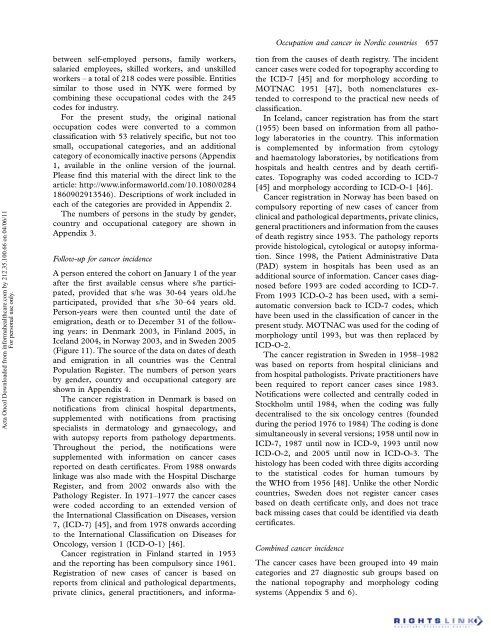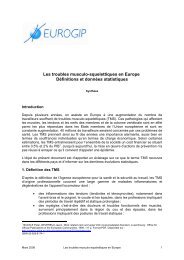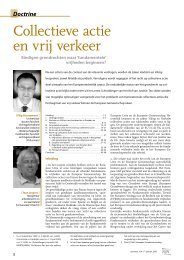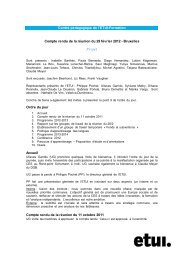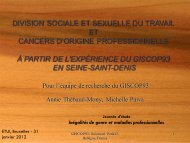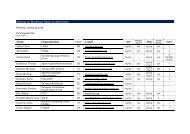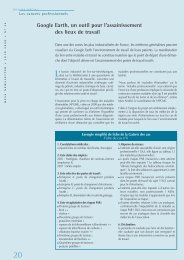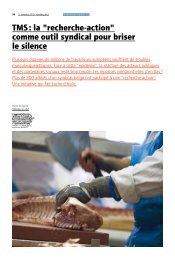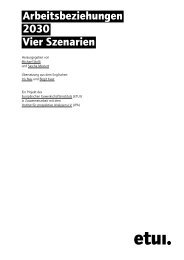Occupation and cancer - European Trade Union Institute (ETUI)
Occupation and cancer - European Trade Union Institute (ETUI)
Occupation and cancer - European Trade Union Institute (ETUI)
You also want an ePaper? Increase the reach of your titles
YUMPU automatically turns print PDFs into web optimized ePapers that Google loves.
Acta Oncol Downloaded from informahealthcare.com by 212.35.100.66 on 04/06/11<br />
For personal use only.<br />
between self-employed persons, family workers,<br />
salaried employees, skilled workers, <strong>and</strong> unskilled<br />
workers a total of 218 codes were possible. Entities<br />
similar to those used in NYK were formed by<br />
combining these occupational codes with the 245<br />
codes for industry.<br />
For the present study, the original national<br />
occupation codes were converted to a common<br />
classification with 53 relatively specific, but not too<br />
small, occupational categories, <strong>and</strong> an additional<br />
category of economically inactive persons (Appendix<br />
1, available in the online version of the journal.<br />
Please find this material with the direct link to the<br />
article: http://www.informaworld.com/10.1080/0284<br />
1860902913546). Descriptions of work included in<br />
each of the categories are provided in Appendix 2.<br />
The numbers of persons in the study by gender,<br />
country <strong>and</strong> occupational category are shown in<br />
Appendix 3.<br />
Follow-up for <strong>cancer</strong> incidence<br />
A person entered the cohort on January 1 of the year<br />
after the first available census where s/he participated,<br />
provided that s/he was 30-64 years old./he<br />
participated, provided that s/he 30 64 years old.<br />
Person-years were then counted until the date of<br />
emigration, death or to December 31 of the following<br />
years: in Denmark 2003, in Finl<strong>and</strong> 2005, in<br />
Icel<strong>and</strong> 2004, in Norway 2003, <strong>and</strong> in Sweden 2005<br />
(Figure 11). The source of the data on dates of death<br />
<strong>and</strong> emigration in all countries was the Central<br />
Population Register. The numbers of person years<br />
by gender, country <strong>and</strong> occupational category are<br />
shown in Appendix 4.<br />
The <strong>cancer</strong> registration in Denmark is based on<br />
notifications from clinical hospital departments,<br />
supplemented with notifications from practising<br />
specialists in dermatology <strong>and</strong> gynaecology, <strong>and</strong><br />
with autopsy reports from pathology departments.<br />
Throughout the period, the notifications were<br />
supplemented with information on <strong>cancer</strong> cases<br />
reported on death certificates. From 1988 onwards<br />
linkage was also made with the Hospital Discharge<br />
Register, <strong>and</strong> from 2002 onwards also with the<br />
Pathology Register. In 1971 1977 the <strong>cancer</strong> cases<br />
were coded according to an extended version of<br />
the International Classification on Diseases, version<br />
7, (ICD-7) [45], <strong>and</strong> from 1978 onwards according<br />
to the International Classification on Diseases for<br />
Oncology, version 1 (ICD-O-1) [46].<br />
Cancer registration in Finl<strong>and</strong> started in 1953<br />
<strong>and</strong> the reporting has been compulsory since 1961.<br />
Registration of new cases of <strong>cancer</strong> is based on<br />
reports from clinical <strong>and</strong> pathological departments,<br />
private clinics, general practitioners, <strong>and</strong> informa-<br />
<strong>Occupation</strong> <strong>and</strong> <strong>cancer</strong> in Nordic countries 657<br />
tion from the causes of death registry. The incident<br />
<strong>cancer</strong> cases were coded for topography according to<br />
the ICD-7 [45] <strong>and</strong> for morphology according to<br />
MOTNAC 1951 [47], both nomenclatures extended<br />
to correspond to the practical new needs of<br />
classification.<br />
In Icel<strong>and</strong>, <strong>cancer</strong> registration has from the start<br />
(1955) been based on information from all pathology<br />
laboratories in the country. This information<br />
is complemented by information from cytology<br />
<strong>and</strong> haematology laboratories, by notifications from<br />
hospitals <strong>and</strong> health centres <strong>and</strong> by death certificates.<br />
Topography was coded according to ICD-7<br />
[45] <strong>and</strong> morphology according to ICD-O-1 [46].<br />
Cancer registration in Norway has been based on<br />
compulsory reporting of new cases of <strong>cancer</strong> from<br />
clinical <strong>and</strong> pathological departments, private clinics,<br />
general practitioners <strong>and</strong> information from the causes<br />
of death registry since 1953. The pathology reports<br />
provide histological, cytological or autopsy information.<br />
Since 1998, the Patient Administrative Data<br />
(PAD) system in hospitals has been used as an<br />
additional source of information. Cancer cases diagnosed<br />
before 1993 are coded according to ICD-7.<br />
From 1993 ICD-O-2 has been used, with a semiautomatic<br />
conversion back to ICD-7 codes, which<br />
have been used in the classification of <strong>cancer</strong> in the<br />
present study. MOTNAC was used for the coding of<br />
morphology until 1993, but was then replaced by<br />
ICD-O-2.<br />
The <strong>cancer</strong> registration in Sweden in 1958 1982<br />
was based on reports from hospital clinicians <strong>and</strong><br />
from hospital pathologists. Private practitioners have<br />
been required to report <strong>cancer</strong> cases since 1983.<br />
Notifications were collected <strong>and</strong> centrally coded in<br />
Stockholm until 1984, when the coding was fully<br />
decentralised to the six oncology centres (founded<br />
during the period 1976 to 1984) The coding is done<br />
simultaneously in several versions; 1958 until now in<br />
ICD-7, 1987 until now in ICD-9, 1993 until now<br />
ICD-O-2, <strong>and</strong> 2005 until now in ICD-O-3. The<br />
histology has been coded with three digits according<br />
to the statistical codes for human tumours by<br />
the WHO from 1956 [48]. Unlike the other Nordic<br />
countries, Sweden does not register <strong>cancer</strong> cases<br />
based on death certificate only, <strong>and</strong> does not trace<br />
back missing cases that could be identified via death<br />
certificates.<br />
Combined <strong>cancer</strong> incidence<br />
The <strong>cancer</strong> cases have been grouped into 49 main<br />
categories <strong>and</strong> 27 diagnostic sub groups based on<br />
the national topography <strong>and</strong> morphology coding<br />
systems (Appendix 5 <strong>and</strong> 6).


